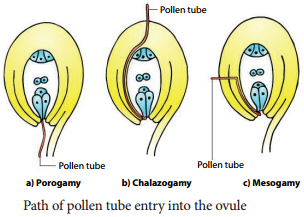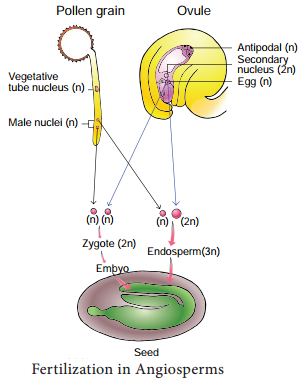Learninsta presents the core concepts of Biology with high-quality research papers and topical review articles.
Fertilization of Asexual and sexual Reproduction in Plants
The fusion of male and female gamete is called fertilization. Double fertilization is seen in angiosperms.
Events of fertilization
The stages involved in double fertilization are:- germination of pollen to form pollen tube in the stigma; growth of pollen tube in the style; direction of pollen tube towards the micropyle of the ovule; entry of the pollen tube into one of the synergids of the embryo sac, discharge of male gametes; syngamy and triple fusion.
The events from pollen deposition on the stigma to the entry of pollen tube in to the ovule is called pollen – pistil interaction. It is a dynamic process which involves recognition of pollen and to promote or inhibit its germination and growth.

Pollen on the stigma
In nature, a variety of pollens fall on the receptive stigma, but all of them do not germinate and bring out fertilization. The receptive surface of the stigma receives the pollen. If the pollen is compatible with the stigma it germinates to form a tube. This is facilitated by the stigmatic fluid in wet stigma and pellicle in dry stigma.
These two also decide the incompatibility and compatibility of the pollen through recognition rejection protein reaction between the pollen and stigma surface. Sexual incompatibility may exist between different species (interspecific) or between members of the same species (intraspecific). The latter is called self-incompatibility. The first visible change in the pollen, soon after it lands on stigma is hydration.
The pollen wall proteins are released from the surface. During the germination of pollen its entire content moves into the pollen tube. The growth is restricted to the tip of the tube and all the cytoplasmic contents move to the tip region.
The remaining part of the pollen tube is occupied by a vacuole which is cut of from the tip by callose plug. The extreme tip of pollen tube appears hemispherical and transparent when viewed through the microscope. This is called cap block. As soon as the cap block disappear the growth of the pollen tube stops.
Pollen tube in the style
After the germination the pollen tube enters into the style from the stigma. The growth of the pollen tube in the style depends on the type of style.
Types of style
There are three types of style
- Hollow or open style
- Solid style or closed style
- Semisolid or half closed style.
1. Hollow style (Open style):
It is common among monocots. A hollow canal running from the stigma to the base of the style is present. The canal is lined by a single layer of glandular canal cells (Transmitting tissue). They secrete mucilaginous substances. The pollen tube grows on the surface of the cells lining the stylar canal.
The canal is filed with secretions which serve as nutrition for growing pollen tubes and also controlling incompatibility reaction between the style and pollen tube. The secretions contain carbohydrates, lipids and some enzymes like esterases, acid phosphatases as well as compatibility controlling proteins.
2. Solid style (Closed type):
It is common among dicots. It is characterized by the presence of central core of elongated, highly specialised cells called transmitting tissue. This is equivalent to the lining cells of hollow style and does the same function. Its contents are also similar to the content of those cells. The pollen tube grows through the intercellular spaces of the transmitting tissue.
3. Semi-solid style (half closed type):
This is intermediate between solid and open type. There is a difference of opinion on the nature of transmitting tissue. Some authors consider that it is found only in solid styles while others consider the lining cells of hollow style also has transmitting tissue.
Entry of pollen tube into the ovule:-
There are three types of pollen tube entry into the ovule (Figure 1.18).

Porogamy:-
when the pollen tube enters through the micropyle.
Chalazogamy:-
When the pollen tube enters through the integument.
Mesogamy:-
when the pollen tube enters through the integument.
Entry of pollen tube into embryo sac:
Irrespective of the place of entry of pollen tube into ovule, it enters the embryo sac at the micropylar end. Th pollen enters into embryo sac directly into one of the synergids. The growth of pollen tube towards the ovary, ovule and embryo sac is due to the presence of chemotropic substances.
The pollen tube after travelling the whole length of the style enters into the ovary locule where it is guided towards the micropyle of the ovule by a structure called obturator (See Do you know). After reaching the embryo sac, a pore is formed in pollen tube wall at its apex or just behind the apex.
The content of the pollen tube (two male gametes, vegetative nucleus and cytoplasm) are discharged into the synergids into which pollen tube enters. The pollen tube does not grow beyond it, in the embryo sac. The tube nucleus disorganizes.
Double fertilization and triple fusion
S.G. Nawaschin and L.Guignard in 1898 and 1899, observed in Lilium and Fritillaria that both the male gametes released from a male gametophyte are involved in the fertilization. They fertilize two diffrent components of the embryo sac.
Since both the male gametes are involved in fertilization, the phenomenon is called double fertilization and is unique to angiosperms. One of the male gametes fuses with the egg nucleus (syngamy) to form Zygote (Figure 1.19).

The second gamete migrates to the central cell where it fuses with the polar nuclei or their fusion product, the secondary nucleus and forms the primary endosperm nucleus (PEN). Since this involves the fusion of three nuclei, this phenomenon is called triple fusion. This act results in endosperm formation which forms the nutritive tissue for the embryo.